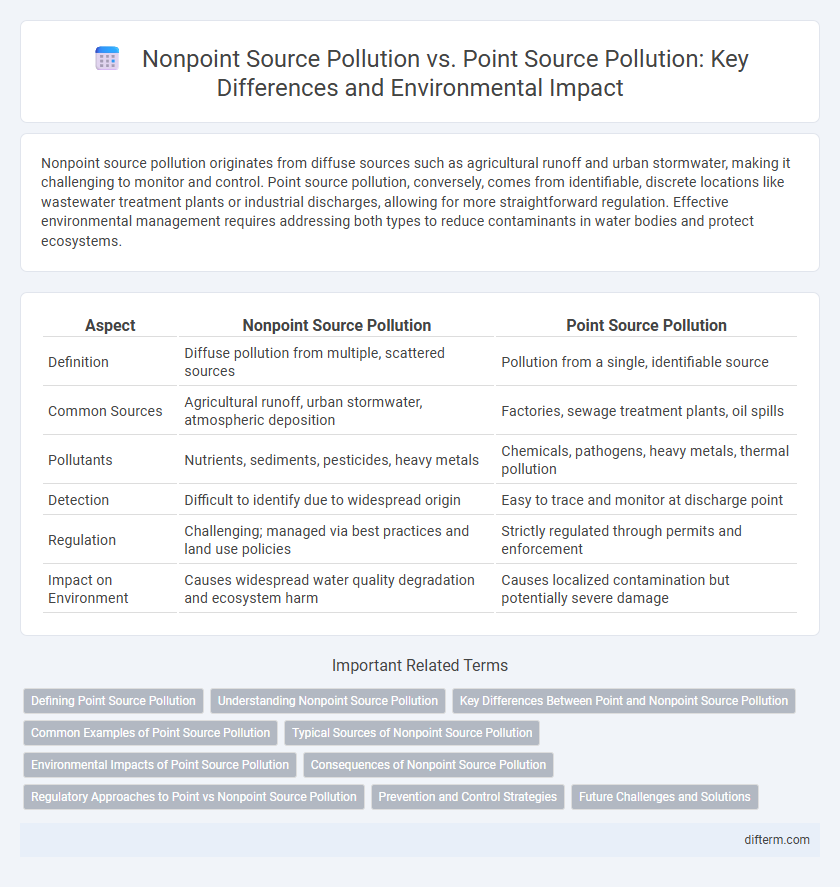Nonpoint source pollution originates from diffuse sources such as agricultural runoff and urban stormwater, making it challenging to monitor and control. Point source pollution, conversely, comes from identifiable, discrete locations like wastewater treatment plants or industrial discharges, allowing for more straightforward regulation. Effective environmental management requires addressing both types to reduce contaminants in water bodies and protect ecosystems.
Table of Comparison
| Aspect | Nonpoint Source Pollution | Point Source Pollution |
|---|---|---|
| Definition | Diffuse pollution from multiple, scattered sources | Pollution from a single, identifiable source |
| Common Sources | Agricultural runoff, urban stormwater, atmospheric deposition | Factories, sewage treatment plants, oil spills |
| Pollutants | Nutrients, sediments, pesticides, heavy metals | Chemicals, pathogens, heavy metals, thermal pollution |
| Detection | Difficult to identify due to widespread origin | Easy to trace and monitor at discharge point |
| Regulation | Challenging; managed via best practices and land use policies | Strictly regulated through permits and enforcement |
| Impact on Environment | Causes widespread water quality degradation and ecosystem harm | Causes localized contamination but potentially severe damage |
Defining Point Source Pollution
Point source pollution refers to contaminants discharged from a single, identifiable location such as a pipe, ditch, or factory smokestack, making it easier to monitor and regulate. This type of pollution typically includes effluents from wastewater treatment plants, industrial facilities, and sewage treatment systems. Controlling point source pollution is critical for preventing harmful substances from entering water bodies and impacting aquatic ecosystems and human health.
Understanding Nonpoint Source Pollution
Nonpoint source pollution originates from diffuse sources such as agricultural runoff, urban stormwater, and atmospheric deposition, making it challenging to trace and regulate compared to point source pollution, which comes from identifiable locations like factories or wastewater treatment plants. Key pollutants include nutrients, sediments, pesticides, and heavy metals that degrade water quality and harm aquatic ecosystems. Effective management relies on implementing best management practices (BMPs), land use planning, and public education to reduce pollutant loads across wide geographic areas.
Key Differences Between Point and Nonpoint Source Pollution
Point source pollution originates from a single, identifiable source such as a factory outlet or wastewater treatment plant, making it easier to monitor and regulate. Nonpoint source pollution comes from diffuse sources like agricultural runoff, urban stormwater, and atmospheric deposition, complicating detection and control due to its scattered nature. The key differences include source traceability, pollutant types, and management strategies, with point source pollution often involving specific contaminants and nonpoint sources contributing to widespread nutrient and sediment loading in water bodies.
Common Examples of Point Source Pollution
Common examples of point source pollution include effluents discharged directly from industrial facilities, wastewater treatment plants, and oil refineries. These sources release contaminants through identifiable conveyances such as pipes or ditches, making regulation and monitoring more straightforward compared to diffuse sources. Point source pollution often involves pollutants like heavy metals, chemicals, and untreated sewage, which can severely impact water quality in nearby ecosystems.
Typical Sources of Nonpoint Source Pollution
Typical sources of nonpoint source pollution include agricultural runoff containing fertilizers, pesticides, and animal waste, urban stormwater carrying oils, heavy metals, and debris, and sediment from construction sites and deforested areas. These pollutants diffuse across landscapes rather than originating from a single, identifiable point, making regulation and mitigation challenging. Rainwater runoff transports these contaminants into rivers, lakes, and coastal waters, significantly impacting water quality and ecosystem health.
Environmental Impacts of Point Source Pollution
Point source pollution, originating from identifiable locations such as factories and wastewater treatment plants, severely degrades water quality by introducing concentrated contaminants like heavy metals and toxic chemicals into ecosystems. This type of pollution causes immediate harm to aquatic life, disrupts biodiversity, and leads to oxygen depletion in water bodies, resulting in dead zones. Regulatory measures targeting point source emissions prove more effective in mitigating environmental damage compared to diffuse sources.
Consequences of Nonpoint Source Pollution
Nonpoint source pollution results in widespread contamination of water bodies, leading to habitat destruction and decreased biodiversity. Excess nutrients from agricultural runoff cause eutrophication, creating dead zones that disrupt aquatic ecosystems. Unlike point source pollution, its diffuse nature makes monitoring and mitigation more challenging, prolonging environmental damage.
Regulatory Approaches to Point vs Nonpoint Source Pollution
Regulatory approaches to point source pollution often involve permits and direct enforcement under frameworks like the Clean Water Act's National Pollutant Discharge Elimination System (NPDES), requiring facilities to monitor and limit specific pollutant discharges. Nonpoint source pollution regulation relies on voluntary best management practices (BMPs), watershed-based planning, and incentives due to its diffuse nature, making traditional permit systems less effective. States implement Total Maximum Daily Loads (TMDLs) to allocate pollutant reductions among nonpoint and point sources, balancing regulatory and incentive-based strategies.
Prevention and Control Strategies
Nonpoint source pollution prevention relies on best management practices such as agricultural buffer strips, urban stormwater management, and controlling runoff through permeable surfaces to reduce diffuse pollutant loads. Point source pollution control involves regulatory measures like permits under the Clean Water Act, wastewater treatment, and industrial discharge standards ensuring direct pollutant sources are treated before release. Both strategies emphasize monitoring and adaptive management to protect water quality and ecosystem health effectively.
Future Challenges and Solutions
Nonpoint source pollution, caused by diffuse runoff from agricultural and urban areas, presents future challenges due to its unpredictable nature and difficulty in regulation compared to point source pollution, which originates from identifiable sources like factories or sewage treatment plants. Advances in remote sensing technology and precision agriculture offer promising solutions to monitor and reduce nutrient runoff, while enhanced regulatory frameworks and implementation of best management practices can control emissions from point sources more effectively. Integrating data-driven approaches with community-led conservation efforts will be crucial for mitigating both pollution types and protecting water quality in the coming decades.
nonpoint source pollution vs point source pollution Infographic

 difterm.com
difterm.com